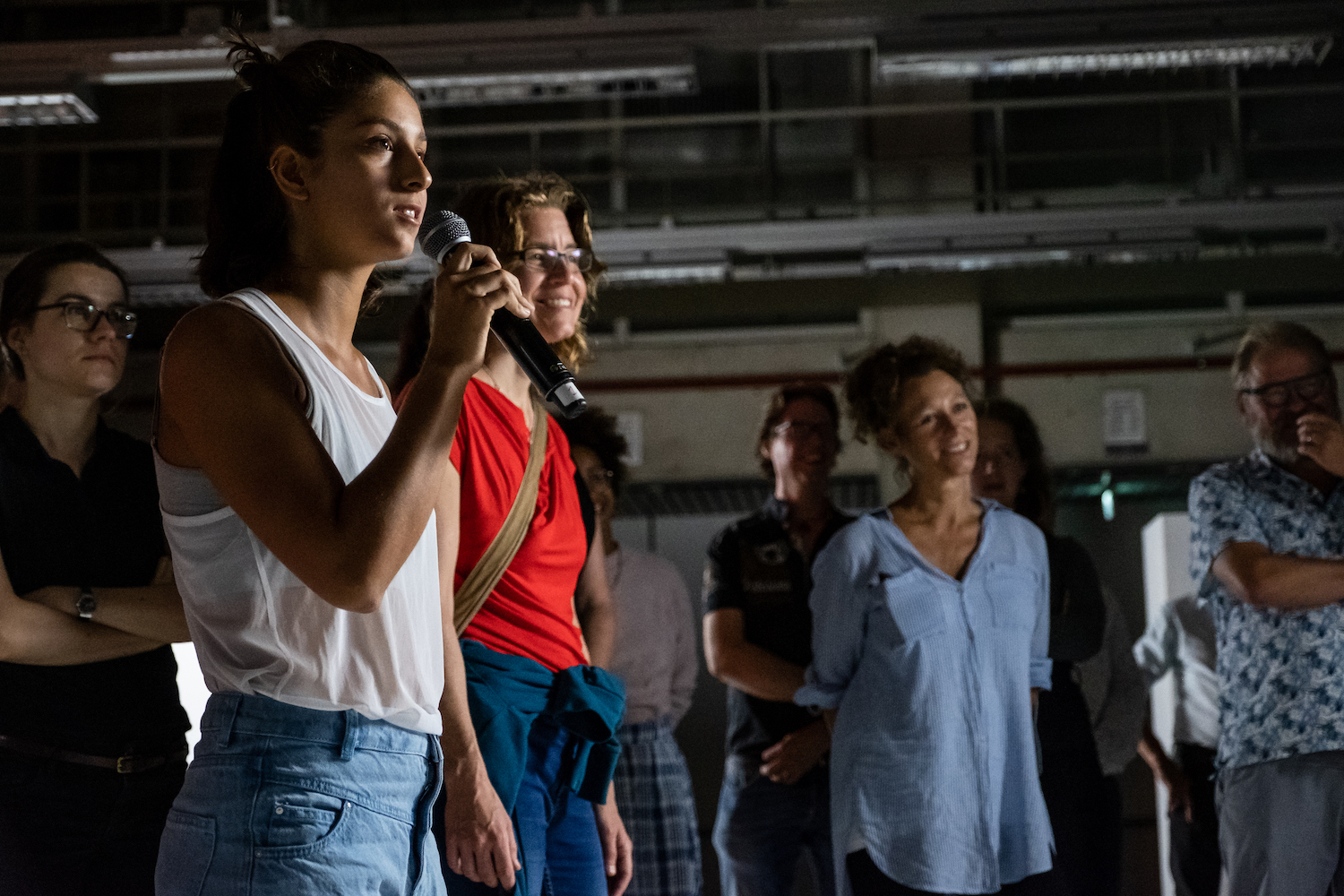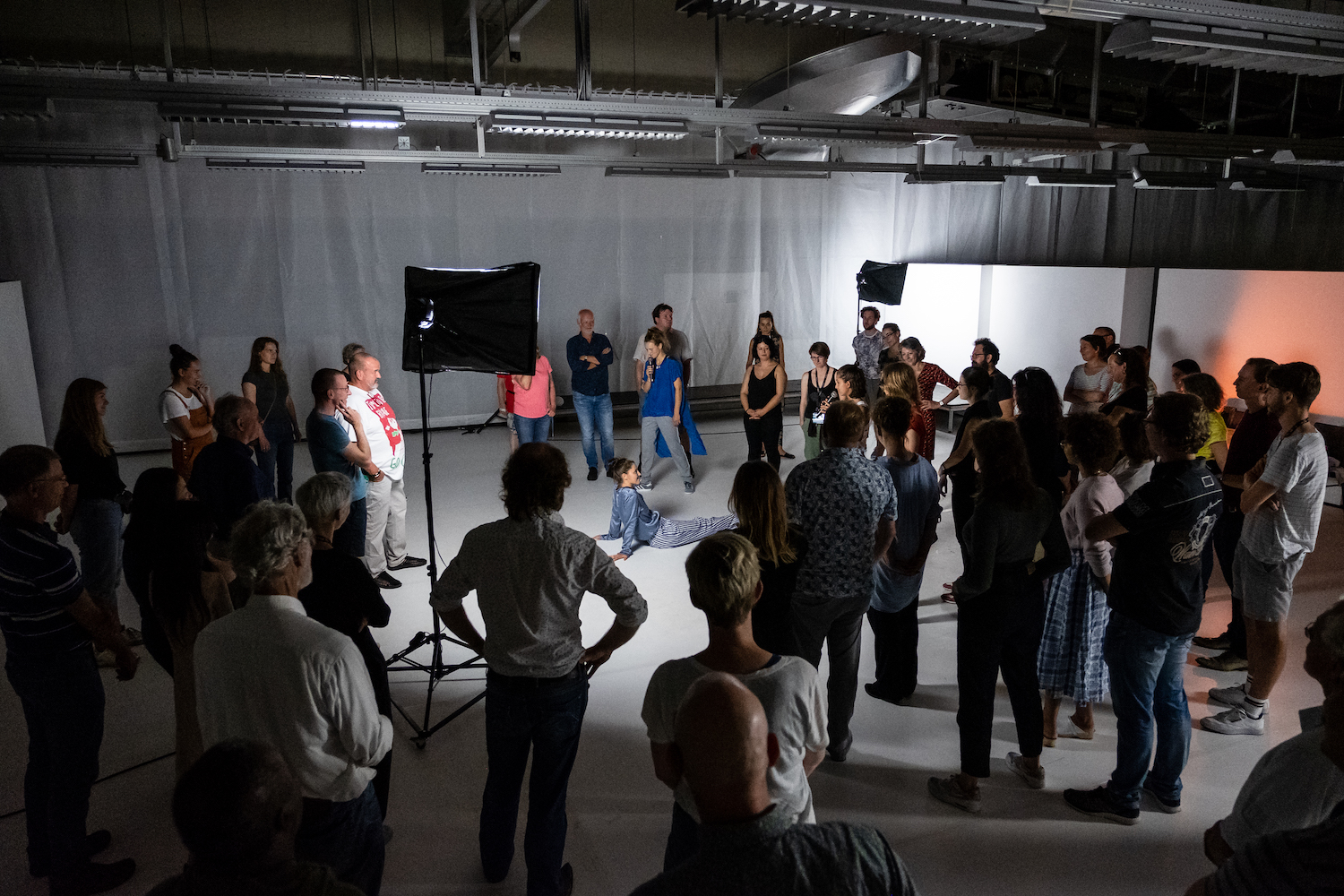There she could/had to participate
Dance&Dare SummerSchool
Elske van Lonkhuyzen went to an interactive performance.
There she could/had to participate.
Text: Elske van Lonkhuyzen
I’ve been using the meditation app Headspace for a year now. There are different sessions of guided meditation you can follow, depending on what you want to work on. I’ve completed Basics 1, 2 and 3, Self-esteem, Generosity, Restlessness and Friendliness, and am now doing Acceptance for the second time.
This session entailed asking yourself: “Who or what am I resisting at this point in my life?” The idea being that only if you are aware of your resistance can you begin to relinquish it.
I resist many things.
I resist being late; I run to catch my train and am angry if the train itself is delayed and I miss my connection.
I resist getting too close to the sweating man standing next to me on the platform, and avert my eyes when he seeks eye contact.
I resist making eye contact with a stranger that three female dancers ask me to do when I arrive – just in time – at the interactive performance Show Me by The100Hands.
I walk around the room with the other members of the audience. We can decide ourselves how we walk and where we stand. We can choose ourselves with whom we make eye contact, as long as it’s with an unknown person. My eyes stray until I find another pair of eyes. They belong to a bald man of about thirty who reminds me of my upstairs neighbour Frank.
The assignment is to keep looking at one another. I’m reminded of the lectures in Social Psychology I used to attend: “Making eye contact for longer than a fraction of a second will result in love or war”, the professor said.
Frank’s eyes dart away every now and then, as do mine. A power struggle of sorts quickly develops. Who can and dares to keep on staring without twitching nervously, without shying away, without moving their feet? At one point I appear to be winning. I don’t want to. I try to look reassuring, nod. I get a nod back.
I expect there are people who approach this type of exercise lightly and inquiringly. Cool people probably, who go through life unconcerned. Like my brother-in-law. He might find this awkward too, but he would come right out and say it and be vaguely amused. I don’t find this amusing. I’m challenged by not being like my brother-in-law.
I’m still busy coming to terms with my own resistance, when the dancers say that if we are interested in getting a different perspective of each other, we can kneel down facing one another. If you decide to kneel down, you should take it in turns and remain kneeling for as long as you like. I don’t want to kneel down. This is mainly because I think that the one kneeling down will end up with his/her face approximately on a level with the other’s crutch and we are standing quite close to one another. I decide there and then not to kneel down and hope ardently that Frank won’t either.
But he does kneel down; there’s nothing I can do about that, of course. I am relieved to note that he leans over backwards to maintain eye contact and that I feel fairly relaxed. When he gets up again, the exercise is over.
The dancers proceed. They walk around, perform a happy dance act and take selfies. Behind a curtain one breast is uncovered. The audience is requested to construct an identity for one of them, based purely on their exterior. “What is her name?” “Where is she from?” “Would you tell her your secrets?” I get the feeling that we are saying anything that comes into our head. “Anna.” “Slovakia.” “No.”
A microphone is pushed under my nose.
“Why not?”
“I don’t tell anyone my secrets just like that.”
I’m finding it difficult to concentrate on the performance. In each part I can decide where in the hall I want to stand. I’m still standing near Frank. Not too close, so that he doesn’t think our eye contact earlier puts him under any obligation, but not too far away either, so that he doesn’t think I found him dumb and wanted to get away fast.
I’m incredibly busy dealing with the freedom I’ve been given. I can stand upright (backache), with my hands in my pockets (hot), or with my arms crossed (defensive attitude, whereas I want to emanate openness). On the outside (too far away from Frank), in the middle (possibly in the way), still (hot feet) or in motion (attracts attention).
I’m reminded of a good friend of ours who, when he comes to stay, finishes off all our milk. He is cheerful and disarming. He has no trouble asking for what he wants. He asks whether he can have the last potatoes, whether the music can be turned up, if I would like to massage his feet. I’m free to say no. Yet if he stays longer than 24 hours, something starts to give. I start hating myself for saying ‘no’ all the time, and then I start to hate the questions which, while leaving me free in my reply, force me to give an answer.
I realize in this hall that ‘can’ is not the right word to use in this context. I can’t decide myself where and how I stand; I ‘must’ decide myself, as there are no fixed places to sit or stand. And then I realize that ‘must’ isn’t the right word either, since I have come of my own free will. And immediately after that: ‘must’ is the right word after all, as that is how the theatre has arranged it. Of course we can ignore the rules of the theatre. I can go and sit down on the floor on the outside; I can run around the room yodelling or flapping my arms; I can leave. But there’s a difference between having an option and actually making use of it.
The dancers ask a boy to take off his T-shirt. Then they ask the audience to place them in different attitudes: strong – sensuous – vulnerable. It takes a while each time for people to respond. We need a lot of encouragement.
We have to make eye contact again. With a new stranger. So Frank is out. After walking around the room for thirty seconds, I find an older man who looks as lost as I feel. One person in each pair has to stand still while the other walks round them and looks at them. First, just the face, then the person standing still can indicate with a snap of the fingers that the other can look at the rest of their body as well.
When the man snaps his fingers, I feel more or less obliged. I scan the rest of his body more from politeness than out of interest.
The people standing still are invited to reveal more of themselves. “You can take off your shoes and socks, for instance”, one of the dancers suggests. There’s a flurry of movement. Bare feet everywhere. It’s warm in the room. The man keeps his shoes on. Straight away I construct theories. He has fungal nails. He thinks his feet smell bad. His wife even said so: “Ted, your feet smell bad.” Suddenly his name is Ted. I’m pleased that Ted keeps his shoes on, he is fully entitled to. “You go Ted,” I think to myself.
“Or you could roll up the sleeves of your shirt”, the dancers say. I get the impression that Ted has only picked up the word ‘shirt’. He lifts up a tip of his, revealing a portion of white belly. His stance is quite tense. I’m fairly sure he is doing this now because he kept his shoes on earlier. That he doesn’t want to say ‘no’ all the time and feels that he owes me something. He is doing something he doesn’t want to do so that I can do something I don’t want to do, which is to look at that white patch of belly, which I do of course, to be polite.
I remember being picked last at gym.
I remember subtle ways of hurting people.
Subtle ways of being hurt.
You survive such things, but what do you learn from them?
At the end of the performance, one of the dancers takes off her clothes. The other two take us on a guided tour of her body, as if it were a planet. Moles are villages; tufts of hair are tropical rain forests. There are mountain chains and rolling hills. Her body is beautiful and not erotically charged when you look at it like this. That puts my mind at rest a little, but my thoughts surge again when I look at the men in the hall. A lot of older men have pushed further to the front to get a good view.
A few days later I see my love. She asks me how the performance went. I tell her about the assignments.
“That’s hardly theatre any more,” is her stern reply, “that’s therapy.”
I can’t help laughing: “Sort of.”
“Was there any after-care?”
“Afterwards you could talk to the dancers. They were very nice. We were a small group from the audience. One person was really grateful; another watched around two-hundred performances a year and had experienced much more awkward interactions. Yet another had flirted during the first round of eye contact and was quite delighted. I didn’t really know what to say.”
“And now, what would you say now?”
“That I recognized the connection between the different parts of the performance: it was all about looking and being looked at. Revealing a lot or a little of yourself. Wanting to look at a lot or a little of another. I saw the connection, but because I had to join in all the time myself, I didn’t see much of the performance. As if participating put up a smoke screen between me and everything else that was happening. Once I had been included in the show like that, all I could look at was myself. I drifted off into my own inner self.”
I look at my nails. They’re too long again.
“I was reminded of your brother”, I said. “He’d probably have called it all ‘a hoot’ at the end and would have gone for a beer.”
She giggles. “Well, after all, you take yourself along to a performance like that.”
“There are performances where you leave yourself in the cloakroom”, I say.
“With the coats.”
“Yes, with the coats and bags.”
ABOUT DANS&DURF/DANCE&DARE
Essay by Elske van Lonkhuyzen after watching Show Me by The100Hands at Theaterfestival Boulevard 2019. Elske is one of the participants in the Dance&Dare SummerSchool, an international project for creative writers who dare to look for new words for dance and performance, by Domein voor Kunstkritiek and DansBrabant. Also read the other essays on DansBrabant’s Blog.

